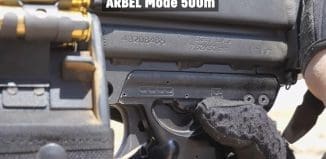Highly Mobile Robot Could Help in Military Patrols
This post is also available in:  עברית (Hebrew)
עברית (Hebrew)
Boston Dynamics has officially unveiled its latest robot after footage leaked earlier in February showing the new design. Known as “Handle” the new research robot incorporates elements from the company’s previous Altas robot, but achieves more efficient mobility by adding wheels and a significantly less complex joint system.
Handle looks to be extraordinarily mobile, speeding down stairs, through snow and leaping up to four feet (1.2 m) vertically. According to the company, Handle can reach speeds up to 9 mph (14.5 km/h) and has a range of 15 miles (24 km) on a single battery charge.
Despite still being labeled a research robot, Handle is also shown to be able to pick up and transport boxes weighing up to 100 lb (45 kg), hinting at potential future commercial uses. The company claims that the combination of wheels and legs offer the robot “the best of both worlds” in the mobility stakes. The wheels also enable a significant reduction in complexity compared to the company’s previous bipedal and quadrupedrobots, with Handle sporting around just 10 actuated joints.
As Wired.com remarks, the Handle robot could be used in a warehouse as a heavy lifter or patrolling with soldiers. The US military wanted the firm’s “BigDog” quadruped for such a purpose, but rejected it in 2015 because it was too noisy.
Rumors circulated for much of 2016 that Boston Dynamics, currently owned by Alphabet, Google’s parent company, was in the process of being acquired by Toyota’s Research Institute. It’s not hard to imagine the numerous ways Handle could be commercially exploited, especially after Toyota announced $1 billion dollars to fund its new robotic research institute in early 2016 and will likely be on the lookout for innovative robotic developments.





























